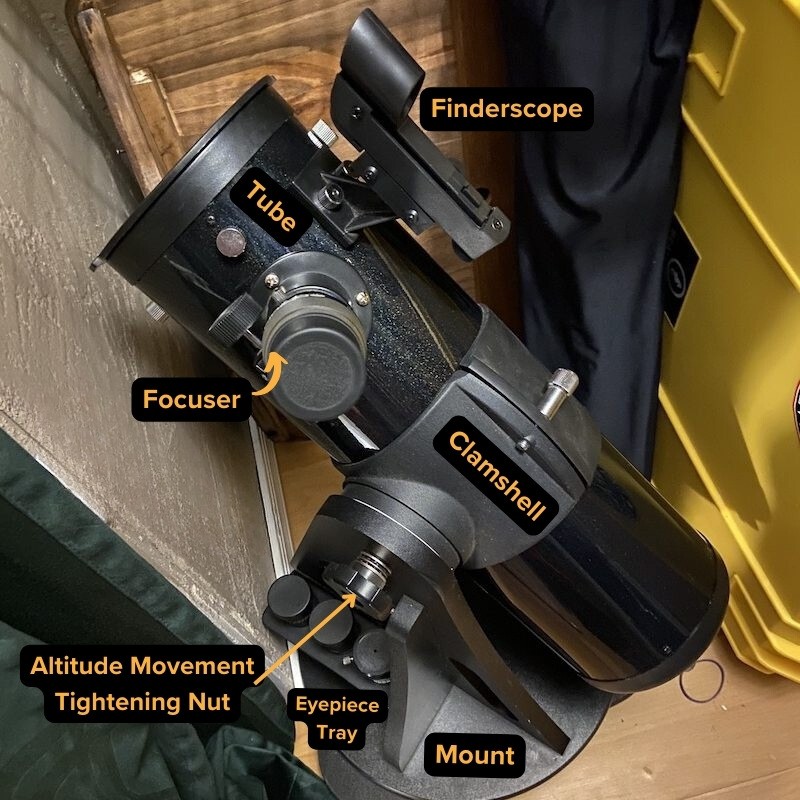
Zhumell Z114’s Optical Tube
The Zhumell Z114’s optical tube is a 114mm f/3.9 Newtonian reflector with a focal length of 450mm.
An f/3.9 focal ratio telescope does have a fair amount of coma. But I chose to ignore it with this instrument, as a 1.25” coma corrector does not currently exist and would cost more than the Z114 itself in any case. The good news is that coma is only an issue with the widest possible fields of view and the lowest magnifications. When viewing many targets, we’ll tend to want to use more medium magnification anyway.
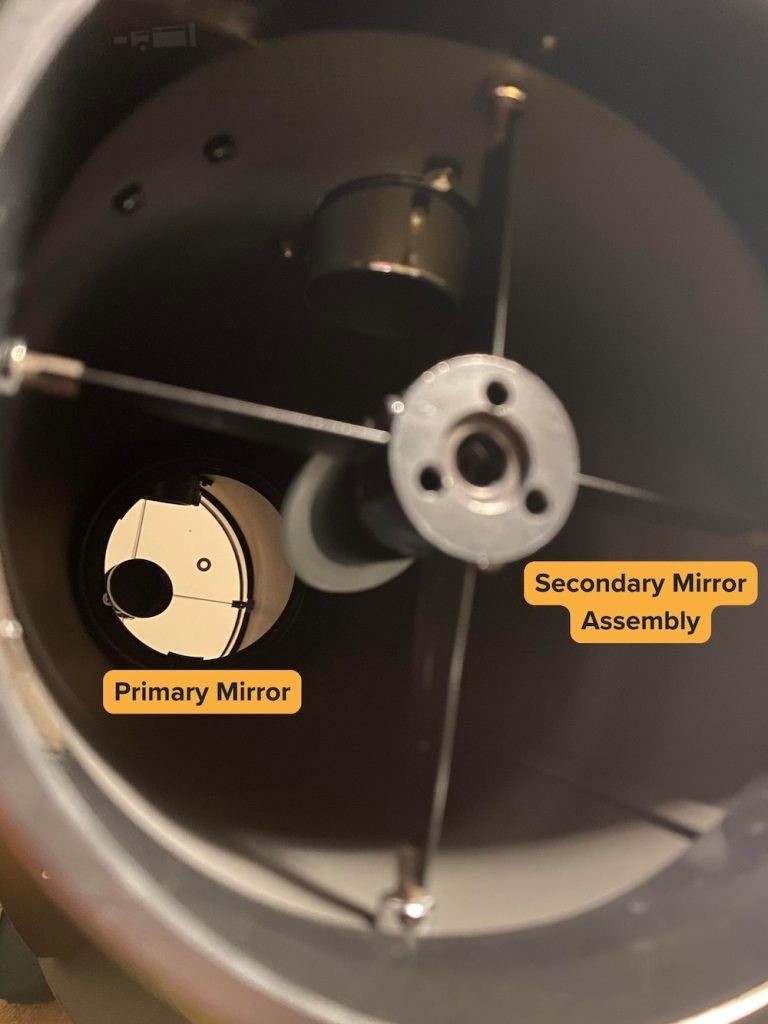
Z114, unlike Zhumell’s own Z100 and most smaller 100mm instruments, can be easily collimated and comes with a parabolic primary mirror that has undergone at least some quality control. So it has no trouble providing sharp images of the Moon, planets, and double stars.
The Zhumell Z114’s focuser (see Image 1 above) is a 1.25” rack-and-pinion unit made mostly of plastic, which works fine. Some units may have a bit of wobble when focusing. I’d fix the wobbling with a strategic placement of tape strips on the focuser’s drawtube and the addition of quality grease/lubricant to the teeth.
The Z114’s optical tube attaches to the mount with a clamshell (see Image 1 above) that allows you to rotate and slide the tube for balance and convenient positioning of the finder and eyepiece. For mounting the Z114 on a full-sized mount or tripod, you’ll need tube rings and a Vixen-style dovetail.
Accessories supplied with Z114
The Zhumell Z114 includes two 1.25” Kellner eyepieces: a 17mm unit providing 24x and a 10mm unit providing 45x.
These are acceptable-quality eyepieces. But neither has a rubber eyeguard. The 17mm shows some edge-of-field aberrations, while the 10mm is rather uncomfortable for me to look through.
The good news is that any quality telescope like the Z114 allows me to interchange any 1.25” eyepieces I’d like, and the included ones are adequate enough to get started. Few beginner telescopes come with eyepieces that I’d call anything other than adequate anyway, and the Z114 costs less than some individual high-quality oculars do by themselves.
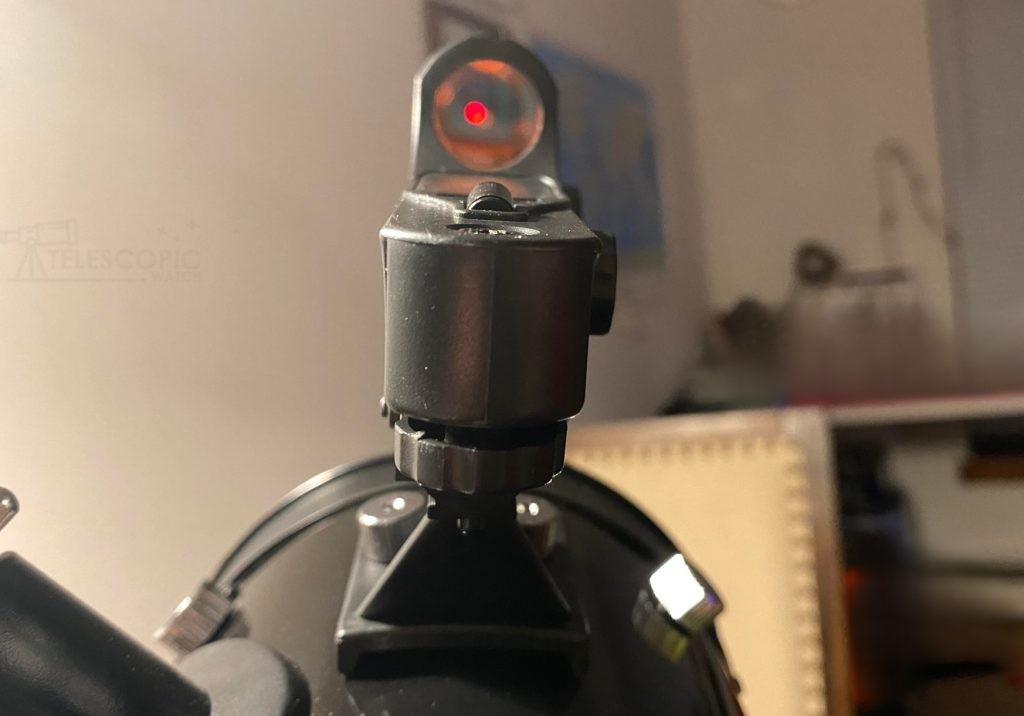
For aiming the Z114, a red dot finder is provided, which easily lines up with the telescope. Thanks to the huge field of view at low power with the Z114, anyone can easily get used to finding deep-sky objects just by roughly aiming the red dot finder and sweeping around for a bit at the eyepiece to locate their target.
There’s no collimation cap included with the Z114, so you’ll have to buy one or make your own out of a film canister. Check out my collimation guide to learn more about collimation and how you can easily collimate your Z114.
The Tabletop Dobsonian Mount
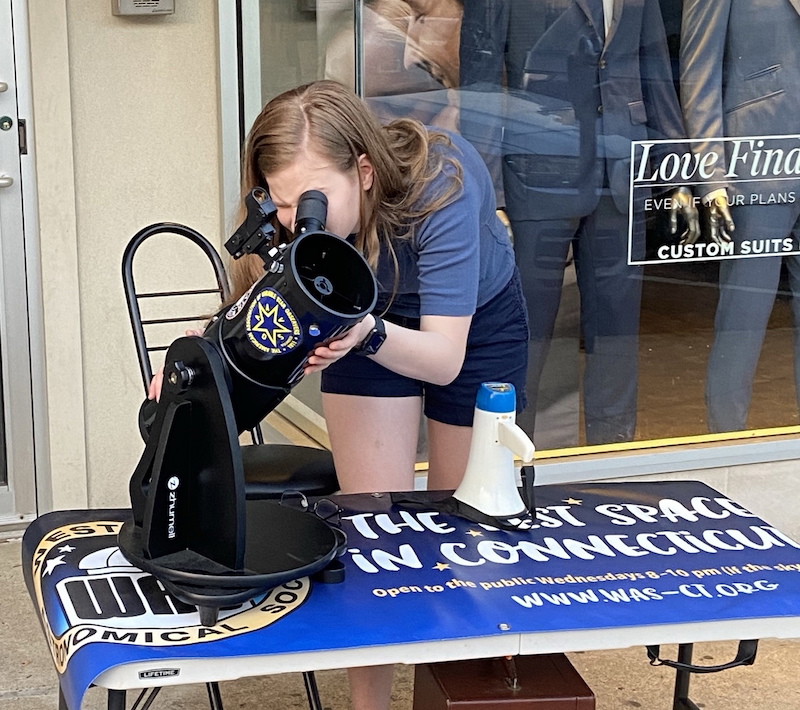
The Z114’s mount is a single-armed tabletop “Dobsonian” mount.
What constitutes a Dobsonian, and the exact nomenclature, is a bit of a hot topic these days. Z114’s altitude bearing is a ball bearing and a nut/bolt that doesn’t really use gravity to its advantage the way a true Dobsonian does.
It moves from side to side, riding on three small plastic pads.
You can adjust the friction on the altitude axis just by tightening the large plastic nut (see Image 1), while the azimuth axis tightness requires two wrenches or pairs of pliers (or a socket wrench).
The Z114 is designed to be used on a tabletop surface, but there are other options. It can’t fit on a photo tripod like a smaller instrument, but a variety of other options will suffice, such as a milk crate, a barrel, a bar stool, the hood of a car, or an easily homemade wooden stand.
Should I buy a used Zhumell Z114?
A used Zhumell Z114 reflector is a great scope. These telescopes haven’t been around for very long, so it’s unlikely you’ll find one with the mirror coatings in poor condition.
A Z114 with damaged mirrors is simply not worth buying, because recoating them costs more than an entire new telescope.
Missing eyepieces or a missing finder, however, are less of a problem. Though again, make sure you don’t wind up spending more on replacing those than a new instrument would cost.
Alternative Recommendations
You may want to go for a slightly bigger or smaller instrument depending on your budget. Here are a few other tabletop Dobsonians we’ve picked for you:
- The Sky-Watcher Heritage 150P offers significantly more light-gathering and resolving power than the Z114 thanks to its larger 150mm aperture, while its tabletop Dobsonian mount is equally easy to use, and the collapsible tube maximizes portability.
- The Sky-Watcher Heritage 130P’s mere 16mm increase in aperture might not sound like much, but it translates to a significant increase in light-gathering and resolving power over the Zhumell Z114 while costing only a bit more; the collapsible tube means the two scopes are basically the same volume when stored.
Aftermarket Accessory Recommendations
The Zhumell Z114 is cheap enough that I wouldn’t recommend going overboard on accessories; you could just buy a bigger scope!
The main thing I’d recommend is a 6mm “gold-line” eyepiece. It’ll give you 75x with the Z114, which is more appropriate for viewing the Moon and planets. A 2x Barlow lens coupled with the 6mm provides 150x, which is nearing the limit of what this scope is capable of.
Other accessories will definitely make your viewing experience better, like perhaps a UHC nebula filter or a better low-power eyepiece, but any one of these nicer accessories is nearing half the cost of the Z114 by itself. So if your budget is bigger, we’d just recommend going for a larger scope from Zhumell if you like what you see here.
What can you see with the Zhumell Z114?
The wide field of view of the Zhumell Z114 makes it a great instrument for low-power sweeping and finding our way around the sky.
- We’ll have no trouble locating dozens of exciting open clusters and many of the bright emission nebulae, such as Orion, the Lagoon, and the Swan.
- Under a dark sky and/or with a nebula filter, we can also spot the Rosette and Veil, two huge nebulae that span across the entire field of view at low magnification.
- Under a typical suburban sky, Andromeda and a few dozen of the brightest spiral and elliptical galaxies are seen, but with little detail. Pop the Z114 into the trunk, and, under dark skies, we have no trouble spotting Andromeda’s dust lanes, M33’s spiral arms, and features in brighter galaxies like M81, M82, and NGC 7331. M51’s spiral arms are even just barely visible, but they’re too small to clearly resolve, and cranking up the magnification dims the galaxy to near-invisibility.
- Globular star clusters are unfortunately beyond the limit of the Z114’s light-gathering and resolution abilities to see as anything more than fuzzy dots, but you can still go after many double stars and, of course, open clusters.
The Z114’s sharp optics also make it a surprisingly good lunar and planetary instrument.
While it is an f/3.9 “light bucket” and collimating it well enough to get perfectly crisp views takes a while, the Z114 has no trouble delivering views just as sharp and detailed as a high-end small refractor, at a fraction of the price and with better deep-sky views to boot.
- We have no trouble spotting the phases of Venus and Mercury, tiny craters and mountains on the Moon, and the ice caps on Mars.
- During the few months biannually that Mars is particularly close to Earth—what’s termed opposition by most astronomers—a few dark markings are visible on the Red Planet on a crisp and steady night, and with careful observing techniques, its outer moon Deimos can even be spotted at favorable times.
- Jupiter’s cloud belts are easy to see, as are the darker polar regions; the Great Red Spot, which is slowly shrinking and may or may not be red, is a bit more challenging, as are the tiny disks and shadows of its 4 large moons when they transit.
- Saturn’s rings are, of course, quite obvious even at low power, with the Cassini Division being resolvable most of the time. We may also be able to see a few of its moons and some pale, low-contrast cloud bands on the planet itself.
- Uranus and Neptune are tiny dots, nearly indistinguishable from stars at low power, and with moons too faint to see. Just finding the two planets is somewhat challenging.

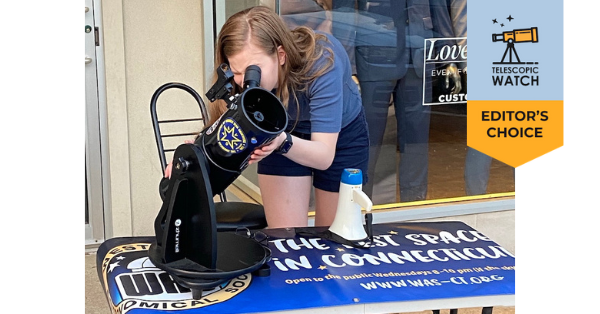
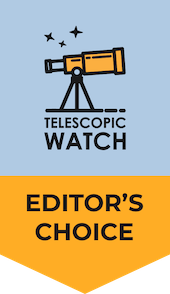

can i see the entire messier catalog with this telescope in some amount of detail
I got mine and within 3 hours it was back in the box on its way back to Amazon. The focuser was so loose it felt like it was going to fall off the telescope if you tried to focus out too far. I’m sorry I don’t think a telescope should need tape in order for it to work properly right out of the box. In my opinion it was the worst $240 I’ve ever spent. Horrible.
Did you try adjusting the screws on the focuser at all?
Zane, thanks for this extremely informative review. One of the best I have found and read. I’m completely new to all this but I followed your recommendations and bought a Z114. I’m thrilled with it. I’m probably going to upgrade the eyepieces as you suggest also. Thanks very much again.